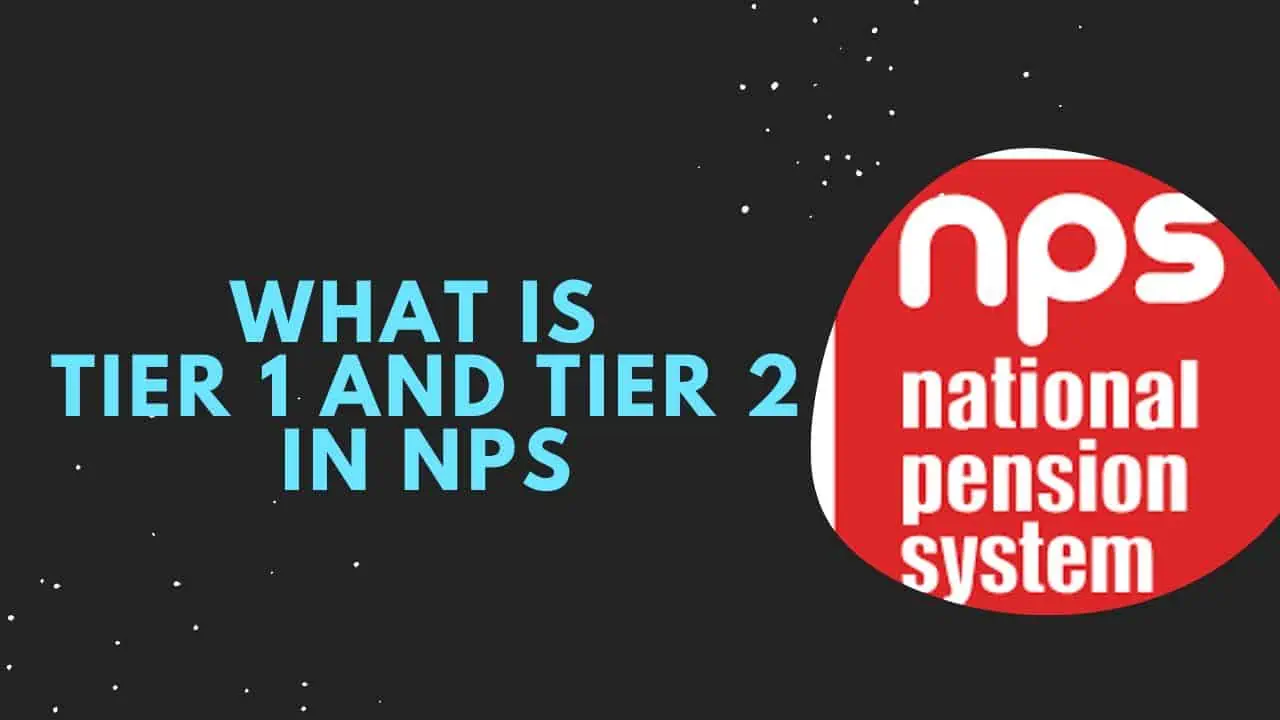What is Tier 1 and Tier 2 in NPS – Tax Benefits, Key Differences, Advantages, and Disadvantages
This post was most recently updated on October 28th, 2023
The National Pension System (NPS) is a popular pension scheme in India. Although it is a pension scheme, it offers some excellent tax benefits and also offers some excellent investment choices via the Tier 1 and Tier 2 NPS accounts.

Before we talk more about Tier 1 and Tier 2 in the NPS, Let’s first understand a few things about the NPS itself.
Consider reading: What is National Pension System (NPS)
Page Contents
What is the National Pension System?
NPS is an easily accessible, low-cost, tax-efficient, flexible, and portable retirement savings account. Under the NPS, the individual contributes to his retirement account via the Tier 1 NPS account.
NPS is designed on a defined contribution basis, wherein the subscriber contributes to his or her own account.
The benefit subscribers ultimately receive depends on the number of contributions, the returns made on the contributions, and the period of contributions. NPS is managed by PFRDA.
You can get all the latest details about NPS on the NPS Trust website.
When was NPS Launched?
National Pension System (NPS) is a government-sponsored pension scheme. It was launched in January 2004 for government employees. However, in 2009, it was opened to all Indian citizens and NRIs who have valid KYC.
What are the Different Types of NPS Accounts?
There are 2 types of NPS accounts :
- NPS Tier 1 account
- NPS Tier 2 account
What is an NPS Tier 1 Account?
An NPS Tier 1 account gets created by default when a subscriber opens an NPS account. When you open an NPS account either offline or online.
You get a Permanent Retirement Account Number(PRAN) generated for you and a default Tier 1 NPS account.
The mandatory contribution for all NPS investments is made via the NPS Tier 1 account.
The NPS tier 1 account investment qualify for all the tax benefits and is used for retirement purpose.
What are the Different Types of Schemes for NPS Tier 1 Accounts?
When you open an NPS account, while creating the NPS Tier 1 account you will get a choice to select the different types of funds which are:
- Asset class E : “High return, High risk” (equity market instruments).
- Asset class G : “Low return, Low risk” fixed income instruments. The best example of this is central government bonds.
- Asset class C : “Medium return for credit risk” bearing fixed income instruments. Examples of these are bonds issued by firms.
- Asset class A : Alternate investments like – Investments in REITs, INVITs, etc.(Currently, Asset class A is not being shown as an option on the NPS website.
Please go through How to fill NPS form online to understand how much % in which fund you can allocate and how you can opt for Auto to allocate your NPS contributions for these funds.
NPS Tier 1 mandates you to have some part of your investment in debt instruments like Class G, and C funds based on your age.
Who are the Different Fund Managers for NPS Tier 1 account?
There are 10 different fund managers in NPS and they are:
- SBI Pension Funds Pvt. Ltd.
- LIC Pension Fund Ltd.
- UTI Retirement Solutions Ltd.
- HDFC Pension Management Co. Ltd.
- ICICI Prudential Pension Fund Management Co. Ltd.
- Kotak Mahindra Pension Fund Ltd.
- Aditya Birla Sunlife Pension Management Ltd.
- Tata Pension Management Ltd.
- Max Life Pension Fund Management Ltd.
- Axis Pension Fund Management Ltd.
Please go through Best NPS fund manager in 2020 for Tier-1 to understand NPS Tier 1 returns and which fund may be best for you.
What are the benefits of the NPS Tier 1 account?
The biggest benefit of an NPS Tier 1 account is tax exemption. Here are the main benefits of an NPS Tier 1 account:
Tax Benefit Available to Individuals:
Any individual who is a Subscriber of NPS can claim tax benefit under Sec 80 CCD (1) within the overall ceiling of Rs. 1.5 lac under Sec 80 CCE.
Exclusive Tax Benefit to all NPS Subscribers u/s 80CCD (1B):
An additional deduction for investment up to Rs. 50,000 in NPS (Tier I account) is available exclusively to NPS subscribers under subsection 80CCD (1B).
This is over and above the deduction of Rs. 1.5 lakh available under section 80C of the Income Tax Act. 1961.
Tax Benefits under the Corporate Sector:
- Corporate Subscriber:
Additional Tax Benefit is available to Subscribers under the Corporate Sector, u/s 80CCD (2) of the Income Tax Act. Employer’s NPS contribution (for the benefit of the employee) up to 10% of salary (Basic + DA), is deductible from taxable income, without any monetary limit. - Corporates
Employer’s Contribution towards NPS up to 10% of salary (Basic + DA) can be deducted as ‘Business Expense’ from their Profit & Loss Account.
What is an NPS Tier 2 Account?
NPS Tier 2 is an optional account that you can create either while you are opening your NPS Tier 1 account or any time after the NPS Tier 1 account is created. You can not have an NPS Tier 2 account without having an NPS Tier 1 account.
What are the Different Types of Schemes for NPS Tier 2 Accounts?
There are 4 types of schemes under NPS:
- Asset class E : “High return, High risk” (equity market instruments).
- Asset class G : “Low return, Low risk” fixed income instruments. The best example of this are central government bonds.
- Asset class C : “Medium return for credit risk” bearing fixed income instruments. Examples of these are bonds issued by firms.
- Asset class A : Alternate investments like – Investments in REITs, INVITs, etc. (Currently, Asset class A is not being shown as an option on the NPS website.
Who are the Different Fund Managers for the NPS Tier 2 Account?
There are 10 different fund managers in NPS Tier 2 and they are:
- SBI Pension Funds Pvt. Ltd.
- LIC Pension Fund Ltd.
- UTI Retirement Solutions Ltd.
- HDFC Pension Management Co. Ltd.
- ICICI Prudential Pension Fund Management Co. Ltd.
- Kotak Mahindra Pension Fund Ltd.
- Aditya Birla Sunlife Pension Management Ltd.
- Tata Pension Management Ltd.
- Max Life Pension Fund Management Ltd.
- Axis Pension Fund Management Ltd.
Please go through Best NPS Schemes to understand NPS tier 2 returns and which fund may be best for you.
What are the Benefits of the NPS Tier 2 account?
The biggest benefit of NPS Tier 2 account is to be able to invest in funds that are investing like large-cap mutual funds/ debt mutual funds with the lowest expense ratio to pay.
The main benefits of an NPS Tier 2 account are:
- Ability to select a pension fund house while account creation.
- Only pay 0.01% as expense ratio for funds
- can select any type of scheme with any % investment choice
- Ability to invest at any time
- Ability to withdraw at any time
- NO exit load
- See all NPS investments in one place
What are Tier 1 and Tier 2 in NPS and What are the Differences Between them?
Here are the key differences between NPS Tier 1 and NPS Tier 2 accounts:
| Feature | NPS Tier 1 | NPS Tier 2 |
|---|---|---|
| Who can invest? | All Indian citizens including NRIs with valid KYC | All Indian citizens including NRIs with valid KYC |
| Can it be opened online? | Yes | Yes(Need NPS Tier 1 account first) |
| Can it be opened Offline? | Yes | Yes(Need NPS Tier 1 account first) |
| Charges for opening account | Same for both | Same for both |
| Investment choice | Same for both | Same for both |
| Minumum contribution at account opening | 500 | 1000 |
| Minumum contribution per annum | 500 | 250 |
| minimum number of contribution per year | 1 | no minimum contribution required |
| Lock in period | No lock-in | No lock in |
| Fund Options available for investment | Till the age of 60 | Same for both |
| Restriction on withdrawal | Yes | No |
| Mandatory purchase of annuity on exit | Yes | No |
| Tax benefits | Yes Section 80CCD(1): Up to Rs 1.5 lacs for own contribution (capped at 10% of basic salary). Included under Rs 1.5 lacs under Section 80C. Section 80CCD(1B): Up to an additional Rs Tax Benefits on investment Tax benefit 50,000 for own contribution. Section 80CCD(2): Up to 10% of basic salary for employer contribution. Benefit under Section 80CCD(1B) and Section 80CCD(2) are over and above Rs 1.5 lacs under Section 80C. Tax Treatment on Maturity (exit) 60% of the accumulated corpus can be withdrawn as tax-free lump sum. Annuity income taxable in the year of receipt | Tax benefit only for Govt employees. No tax benefits for ordinary citizens. |
| Tax treatment on maturity | 60% of maturity amount is tax free. Rest 40% mandatory annuity. | Gains added to income |
FAQs on What is Tier 1 and Tier 2 in NPS
Which NPS is good Tier 1 or Tier 2?
Tier I NPS is ideal for retirement planning, while Tier II NPS serves as a voluntary savings account. Unlike Tier I, funds invested in Tier II accounts can be withdrawn at any time. When deciding between Tier I and Tier II, consider your long-term goals and the flexibility you need for accessing your investment. Invest wisely based on your financial objectives.
Can we have both Tier 1 and Tier 2 NPS accounts?
Yes, you can have both a Tier 1 and Tier 2 NPS account. To open a Tier 2 account, you must first have a Tier 1 account. The Tier 2 account offers flexibility in withdrawals and exits. Enjoy the benefits of both accounts for a secure and flexible retirement planning strategy.
What is the full form of NPS?
NPS stands for National pension system.
What is the full form of PRAN?
PRAN stands for Permanent Retirement Account Number.
Can I have two NPS accounts?
No. You can not have two NPS accounts. when you create an NPS account, you get allocated a PRAN number which is portable and can be used anywhere even if you switch jobs.
Can NRI contribute to NPS?
Yes NRIs with valid KYC can contribute to NPS via their NRE/NRO account.
How many times we can contribute to NPS in a year?
There is no upper limit to NPS tier or tier 2 contribution. For NPS tier 1, you need to mandatorily invest at least once a year otherwise your NPS account gets frozen.
Can we stop NPS in between?
If you wish to stop NPS contribution before the age of 60 then you can only withdraw 20% of your investments and purchase an annuity for test 80% value. If you don’t withdraw or invest money into your NPS account then your NPS account gets frozen.
Can I pay NPS monthly?
Yes, you can invest in your NPS account monthly.
What is the NPS interest rate?
Typically 12-14%. Although there is no absolute formula to calculate the NPS interest rate the rate of returns depends on your fund allocation. If your contribution is for a long time and if you have selected the equity option then you may benefit from higher returns.
What is the benefit of NPS?
The benefit of having an NPS account is tax efficiency. Section 80CCD(1B): Up to an additional Rs Tax Benefits on investment Tax benefit 50,000 for own contribution is only available for NPS investments.
Is it a must to have NPS Tier 1 account?
Yes. NPS Tier 1 accounts are by default created when you signup for NPS. You can’t have an NPS account with out NPS Tier 1 account.
Is it a must to have an NPS Tier 2 Account?
No. NPS Tier 2 is an optional account. You don’t need to create NPS Tier 2 account if you don’t need it.
Is NPS better than Mutual Funds?
NPS investments are better than mutual funds when you consider the 80CCD(1B) tax benefits. If you are in a higher tax slab then NPS is an excellent choice for you for investments.
Is Tier 2 NPS taxable?
The gains from Tier 2 NPS are taxable and are added to your total income for the FY.
Is NPS Tier 2 better?
Yes, NPS Tier 2 can be a better choice for investors seeking simplicity and limited access to financial advisors. It offers an auto-choice feature for asset allocation, relieving investors of the need to manage allocation themselves. NPS Tier 2 provides a suitable option for those who want a straightforward approach to investment.
Which NPS Tier 2 Scheme is best?
The top-performing NPS Tier-II Returns 2023 – Scheme E is considered the best option for those looking for the best NPS Tier 2 returns. This scheme provides attractive returns and benefits to investors. By investing in this scheme, you can maximize your returns and achieve your financial goals effectively.





